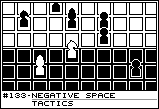|
Mechanic #133 - Negative Space Tactics |
 | Posted: 11/30/11
What happens when you combine Chess and Tetris? A tactical game where the playing field is always changing. |
![[nschess1.png]](set07/img/entry133-nschess1.png)
Fig 133.1 - The Board.
This is a simple tactics game. I've used-chess like figures to represent the units, but that's largely because chess figures have unique silhouettes (kind of a requirement when you have 1-bit to work with). The units themselves are stronger or weaker depending on the color they are standing on (which figures on a black square are stronger than white figures on a white square), and in Chess, there are instant captures and thus no concept of relative strength. So just assume that this is a typical Shining Force-style tactics game... although, moving in patterns like Chess could be an interesting wrinkle.
Calling this a Negative Space guy is a bit of a cheat. The idea originally called for two units of opposite colors, making black and white the obvious choice. You'll notice that the units also have a halo around them, allowing them to move from white squares to black squares without losing form. You don't actually play in the negative space of one side or the other. It is a simple gridded chessboard, only in that some of the squares are white and some are black.
The gray squares are considered walls. Units can not move through them.
![[nschess2.png]](set07/img/entry133-nschess2.png)
Fig 133.2 - The Shared Hand.
There is a single shared deck of cards to the side of the board. Five cards are taken from the top of the deck and layer out between the players. On each player's turn, they select one of the five visible cards in their color and perform the action listed on the front, or they can select a single card of the opponent's color and discard it immediately.
The most basic card is a move card, allowing a player to move one or more of his pieces in a single turn. The number and types of pieces are pictured on the front. If it says you can move two pawn-like characters, you can select and two (different) figures from your set of pawns on the board. If you only have one pawn, you can only move one. If you can't move any of the figures on the card, discard it.
Occasionally, it will include an opponent's piece as well, allowing you to move a figure of that type - presumably into a trap or out of your way.
|
Changing the Board For All the Right Reasons |
In addition to movement cards (and whatever other kinds of combat cards you want, like events or special effects), there are a couple card types that will affect the playing field by changing the color of the squares below the units. Each one has a Tetris piece-like shape that can be placed on the board, though depending on the card's type, it could have a different effect on the what happens.
![[nschess3.png]](set07/img/entry133-nschess3.png)
Fig 133.3.1 - Placement Cards.
The result is more or less based on bit copy operations. The most basic one is to copy the bits from the source to the destination. When asked to place a shape, its color is copied to the board as is. When placing a colored shape, at least one cell must be of an identical color as one of the spots on the grid it occupies (you can grow black shapes out of black areas).
![[nschess3-2.png]](set07/img/entry133-nschess3-2.png)
Fig 133.3.2 - A Copy Operation.
The result of a copy operation is that the black cross is copied as is to the field, overwriting anything underneath it (including the gray walls). When placing gray wall shapes, you must overlap your own color on the field for at least one square AND you may not create walls on top of units.
![[nschess4.png]](set07/img/entry133-nschess4.png)
Fig 133.4.1 - Inversion Cards.
The second operation that can be performed is an invert. This will switch the colors under the shape. Like the placement cards, when placing a colored shape, at least one cell must share the same color as the grid square below it. This will be inverted after placing.
![[nschess4-2.png]](set07/img/entry133-nschess4-2.png)
Fig 133.4.2 - An Invert Operation.
For every cell in a shape, the grid square on the board will change to the opposite color. Black to white, white to black. However, inverting a gray wall has no effect (inverting dithered gray just results in dithered gray). Invert operations will not create walls.
![[nschess5.png]](set07/img/entry133-nschess5.png)
Fig 133.5.1 - Exclusive Or Cards.
The final operation is the Exclusive Or operation. Simply put, white plus white equals zero, as does black plus black. However, white plus black or black plus white equals one. To put this into game terms, when putting a black XOR shape on the field, black squares remain black, but white squares become gray walls (even if a unit is standing there). And again, placing a shape requires that at least one square matches your own colored square on the board. A black cross needs to be tethered to at least one black cell on the board.
![[nschess5-2.png]](set07/img/entry133-nschess5-2.png)
Fig 133.5.2 - An XOR Operation.
It's not a strict XOR operation, but it's been a while since I've done bitmap bit copy operations so I'm just going to chalk it up to laziness on my part. Basically, anything that isn't a white square is turned into a black square. This will erase gray walls.
The end result is an unpredictable tactical game where the board is always changing. You don't have complete control over your own tactical options, relying on the unpredictability of what is dealt and the grumpiness of your opponent, but you still have multiple potential moves at your disposal. Being able to see the cards your opponent might pick allows you to plan a little farther ahead as well. |